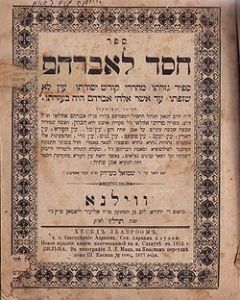A Short Tribute
Hacham Avraham Azulai, son of Mordecai, was born in 1570 in Fes, Morocco. As a young man, he studied Torah and Halacha with the sages of Fes. After having studied the riches of the Torah’s explicit wisdom, he began to delve into its concealed aspects.
In 1600, at the age of 30, he immigrated to the Land of Israel. He survived a shipwreck but his writings were all lost. From that time on, he used the shape of a ship as his signature.
Hacham Avraham Azulai settled in the city of Hebron, where he studied and elucidated the RaMaK’s work [Moses ben Jacob Cordovero, HaOr Yakar].
In 1619, following the outbreak of a severe epidemic in Hebron, Hacham Avraham Azulai left for Jerusalem. When the epidemic reached Jerusalem, he left for Gaza and vowed that if he would succeed in returning to Hebron he would have all the original Torah commentary he had written over the years published. When the epidemic subsided, Hacham Avraham Azulai returned to Hebron, where he lived for the remainder of his life. Two daughters and a son – Hacham Yitzhak Azulai, our Master the HIDA’s grandfather, Chaim Yosef David Azulai, succeeded him.
Hacham Avraham Azulai passed away on 24 Cheshvan 5404 (1643) and was buried in Hebron. He wrote down much of his original commentary. Some has remained in manuscript form, and some has been published in the following books: Or HaHama – a concise commentary on the Zohar, Or HaLevana – edits and corrections on the Zohar, Zoharei Hama – a summary of the book Yerach Yakar, Or HaGanuz - the hidden lore of the Torah according to the HA’ARI [Rabbi Isaac Luria], Chessed Le’Avraham – explanations on the Bible, Ahava Ba’Ta’anugim – a commentary on Tractate Avot.
